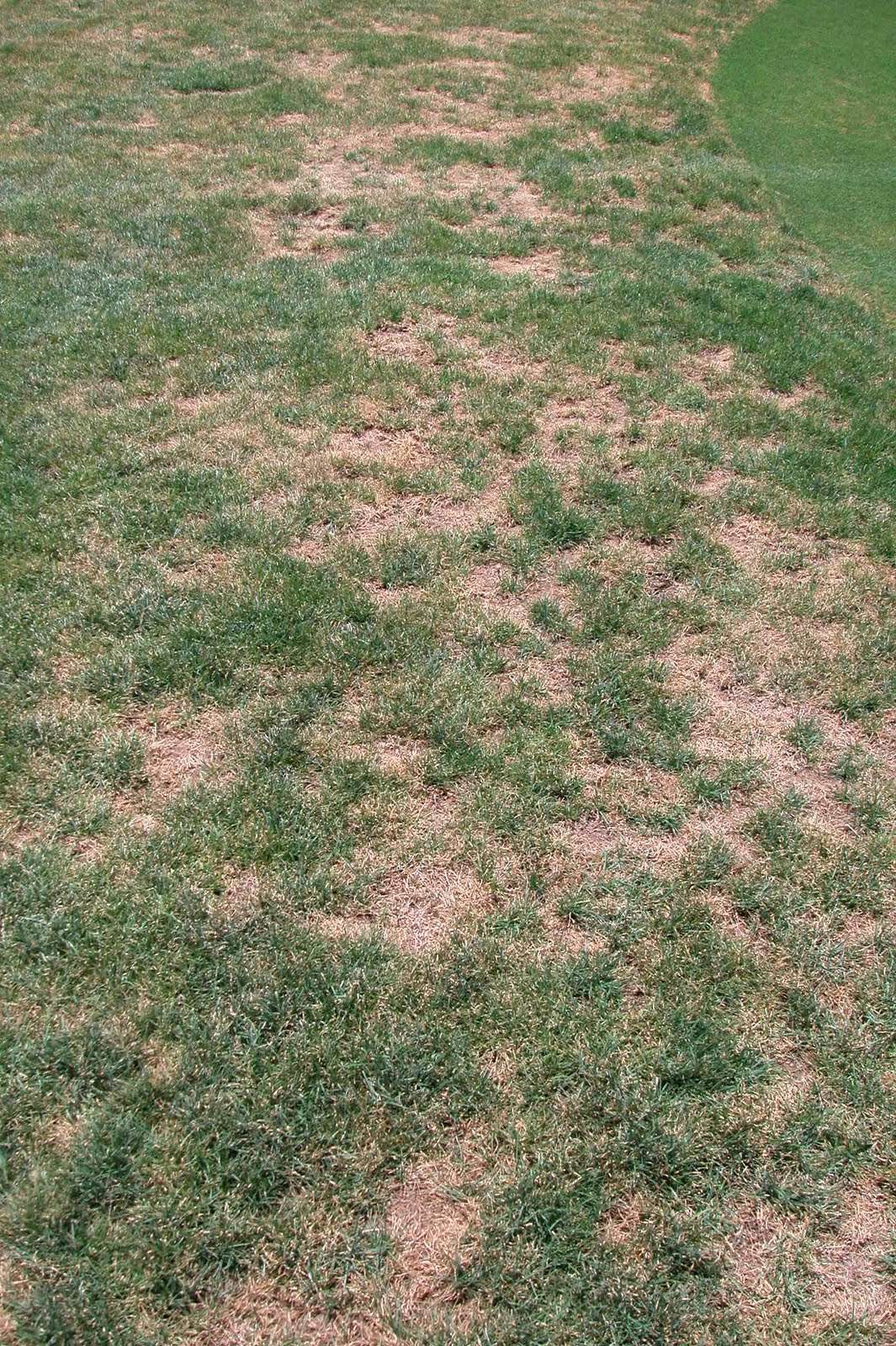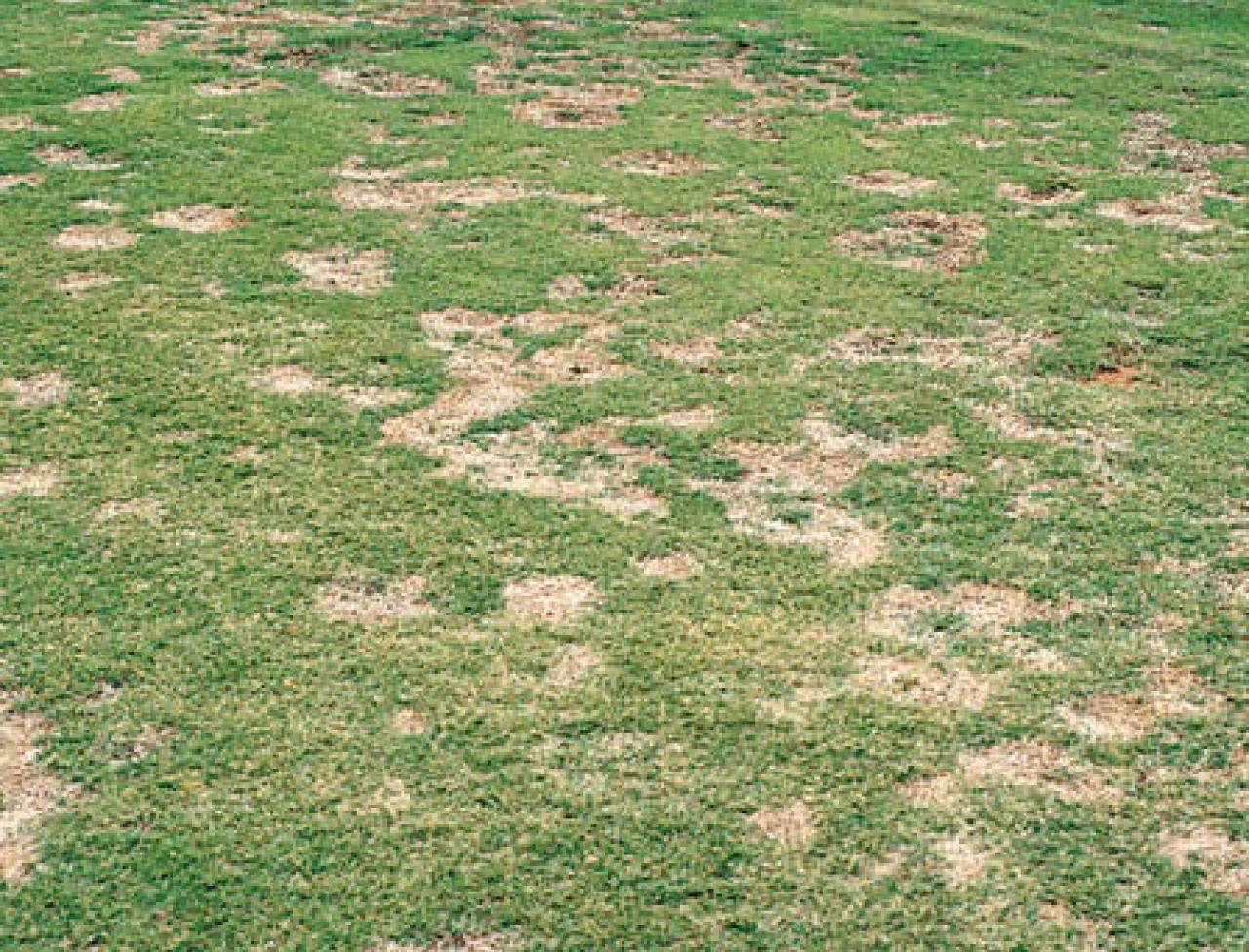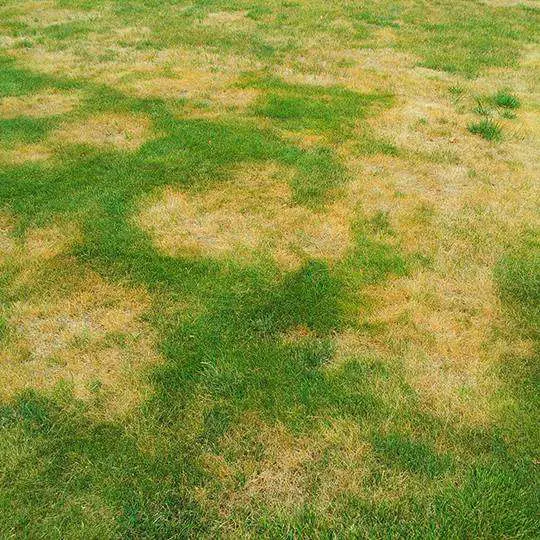How To Control Dollar Spot
The best approach to control Dollar Spot in your lawn is through proper lawn care maintenance.
Proper lawn care maintenance ensures a healthy lawn and includes adequate fertiliser, reduction of thatch levels, aeration, morning watering that is deep and infrequent and mowing at regular intervals.
Alternately if the above lawn care maintenance procedures do not work, fungicides with the Common Active Ingredient Propiconazole should be used.
myhomeTURF recommends using Bumper an effective fungicide that can be purchased through our myhomeTURF online store.
Pillar G Intrinsic Granular Fungicide
Active Ingredients: Pyraclostrobin and TriticonazoleTarget Funguses: Over 20 diseases including Brown Patch, Dollar Spot, Melting Out, Pythium Blight, Red Thread, Rust, and more.FRAC Group 3 & 11
Pillar G is one of the few granular fungicides that we recommend. Generally speaking, liquid fungicides are much better options for lawn fungus control. Granules need to be watered into the soil and its ingredients are drawn up through the roots where liquids can be sprayed directly onto the grass blades with a backpack sprayer and become more quickly activated into the grass foliar.
Best used as a prevention. Apply 3 lbs. of Pillar G per 1,000 sq. ft. to control a broad spectrum disease prevention of funguses. Be sure to rotate with other non-Group 3 or 11 fungicides every two applications to best control lawn disease.
Active Ingredients: Thiophanate-methylTarget Funguses: Anthrancose, Brown Patch, Dollar Spot, Leaf Spot, Red Thread, Snow Mold, Rust, Summer Patch, and more.FRAC Group 1
Clearys 3336 F fungicide is a broad-spectrum disease prevention fungicide providing very good disease prevention and curative properties for turfgrasses. This FRAC 1 fungicide is a great option to rotate with any of these other fungicides listed in this post . Apply between 2-6 oz. per 1,000 sq. ft. depending on the type of fungal disease.
Note: there are several restrictions and may not be available in your state.
What Is Lawn Rust
Rust is a fungal disease that occurs on your lawn when its growth is slowed.
Rust usually appears in late summer or early autumn and during periods of dry weather or when the grass is low on nitrogen.
Lawn Rust weakens the strength of your lawn and makes it more susceptible to other diseases and turf problems.
The Rust is identified by pulling a couple of blades out of the lawn. The lawn blades will be coated with orange-red to yellowish brown dust or spores.
Lawn rust begins with yellowing leaf blades and small yellowish spots which mature to orange, red or brown colouring.
The Rusts spores can be rubbed off the grass blades with a finger.
Overall, rust patches of the grass will become thin and weak.
Don’t Miss: What Kind Of Oil Do I Use In My Lawn Mower
What Is Brown Patch In Your Lawn
Brown Patch is a lawn summer disease caused by a fungus and is rife during warmer months when the humidity is high.
Once started, Brown Patch can quickly spread on your lawn with damage first appearing as a circular area of brown and dead grass enclosed by a darker colour.
Typically, Brown Patch infects lawns of poor health.
How To Identify Common Fungal Lawn Diseases

In order for fungal diseases to strike, three factors must be in play: disease pathogens, weather conditions that favor disease development, and susceptible lawn grasses. Without all three factors present, grasses keep the upper hand. While you can’t control the weather, you can recognize fungal threats, learn how to identify lawn and grass diseases, and take action.
Active fungal disease usually occurs in times of stress, which vary according to grass growing regions. For example, warm-season grasses are hit when abnormally cool temperatures slow their growth cool-season grasses are most vulnerable under warmer than normal conditions. Excessive rain, drought and overcast skies all impact your lawn’s ability to fight back.
You can identify the following common fungal lawn and grass diseases for warm- and cool-season grasses with the lawn and grass disease tips that follow:
Close-up view of symptoms of Brown Patch in grass.
- Circles of dead, sunken grass appear that can vary in size up to 3 feet wide.
- Grass blades darken, wilt and die, leaving the circle’s perimeter smoke-gray in color.
- Perennial ryegrass, tall fescue, bentgrass and Bermudagrass are hit by brown patch most often. Kentucky bluegrass, fine fescue grasses and St. Augustine grass are commonly affected, too.1,2
- In the spring and fall, warm to hot weather conditions set the stage for brown patch lawn disease.
- Wet leaves, high humidity, overfertilizing and excess water facilitate the spread.
Red Thread close up.
Read Also: Kijaro Lawn Chairs
What Is Summer Patch
Summer patch is a lawn disease that is caused by the fungus Magnaporthe poae. The disease is characterized by irregular circular patches that may grow up to 12 inches in diameter. Summer patch symptoms include straw-colored patches, wilted turf, and a frog eye effect that is sometimes noted in the middle of a brown patch where turf stand may resist the infection. These crescents and half-moons are different than brown patch fungus which are usually full circles, and dollar spot that starts out as much smaller silver dollars.
Summer patch disease affects the root system of infected grasses particularly Poa species and fine fescue preventing it from delivering nutrients and water to grass blades. The disease tends to thrive on lawns where soil temperatures are above 65 degrees Fahrenheit. Generally, creeping bentgrass and perennial ryegrass are resistant and not affected by summer patch.
What Is Red Thread
Red Thread is a fungal disease found on lawns and is circular or irregularly shaped with small to large patches in diameter.
The first symptom of Red Thread in turf is the tan colour of dead grass leaves.
Dead lawn leaves caused by Red Thread are generally interspersed among uninfected leaves giving an overall diffuse, scorched or ragged appearance to the patch.
Red Thread thrives in temperatures between 17°C to 29°C which are also humid.
Read Thread causes fungus primarily during periods when grass is growing slowly as a result of low temperatures, drought or inadequate fertility.
Recommended Reading: Lawn Mowing Advertising Ideas
Signs Of A Diseased Lawn
- White, yellow or brown patches or rings that grow in a diameter
- Thin patches of frayed, discolored, or distorted grass
- Grey, red, black, purple or orange spots on individual blades of grass
- Grey, pink, or black powdery or threadlike coatings on the blades of your grass
- Areas of dark slimy wet, or greasy-looking grass
How To Control Brown Patch
The best approach to control Brown Patch in your lawn is through proper lawn care maintenance.
Proper lawn care maintenance ensures a healthy lawn and includes adequate fertiliser, reduction of thatch levels, aeration, morning watering that is deep and infrequent and mowing at regular intervals.
Alternately if the above lawn care maintenance procedures do not work, fungicides with the Common Active Ingredient Prodione should be used.
myhomeTURF recommends using Indigo Voltar an effective Broad Spectrum Fungicide that can be purchased through our myhomeTURF online store.
Also Check: How Do I Keep Geese Off My Lawn
Reseed With Resistant Grass Varieties
Where all other efforts fail you may need to reseed with a turfgrass variety that has known resistance to this fungus. A variety of grasses are available with moderate resistance to the Rhizoctonia fungus. If a brown patch is an annual occurrence, consider top-seeding your lawn with resistant grasses. Check with your local university extension service on recommendations for resistant grass species.
Overseed With New More Tolerant Grass Seed
Now you have raked and scarified there should be plenty of visible soil on which to spread new grass seed.
Make sure you spread a seed mix which contains grasses that arent affected by Take All Patch. Fescues and ryegrasses are perfect.
Depending on the type of lawn you have will depend on the type of grass seed you choose:
- For play areas use a hard wearing grass seed which consists of only ryegrasses.
- If you have a family lawn that you want to look nice use a multipurpose seed mix that contains both fescues and ryegrasses.
- For ornamental lawn use a blend that only contains fescue grasses.
If you want to know more about which grass seed is best for you, .
Also, this article will show you how to overseed your lawn properly.
Read Also: Home Depot Hydroseed
Common Summer Lawn Diseases
Summer Lawn Diseases can be some of the most damaging problems we encounter. Being careful about how we maintain our lawns leading up to the summer months is very important in preventing these diseases.
Preventing diseases is always easier than stopping them once they start. The good thing is that modern approaches are much better at solving problems then they used to be.
How To Repair Lawn Spots Damaged By Summer Patch

Once summer patch is under control, repair the damaged areas quickly and easily by using an all-in-one patch and repair mix like Scotts® EZ Seed®. It contains high-performance grass seed, continuous release fertilizer, and super-absorbent growing material to help grow grass wherever you need it. Check the package for directions, and use this product during spring or fall for best results. Another option is to overseed your entire lawn with Scotts® Turf Builder® ThickR Lawn Sun & Shade or Scotts® Turf Builder® ThickR Lawn Tall Fescue Mix during early spring or fall to help restore your lawn to its original thickness.
Recommended Reading: Lawn Mowers Made In Usa
Managing Patch Disease In Lawns
Rings of dead grass are typical symptoms of patch disease.
Summer patch, Magnaporthe poae, and necrotic ring spot, Leptosphaeria korrae, are two separate diseases which attack turfgrass roots and previously were referred to as fusarium blight. Research continues to look for information on these diseases. Brown patch, Rhizoctonia solani, may also attack lawns. These “patch diseases” are similar in appearance and management.
Summer patch and brown patch tend to be most active in hot weather, while necrotic ring spot tends to be most active in late spring and in fall. Disease symptoms often show under lawn stress in summer, however. Crescent shaped or circular patches of dead grass, often with clumps of green grass inside, are a characteristic symptom . Lawns with advanced disease development may show irregular dead areas and streaks.
Patch diseases typically develop on lawns with stress factors such as excessive thatch, poor soil conditions, sod installed over a poorly prepared site, irregular/excessive nitrogen fertility, and related problems. One typical situation in which these diseases occur is recently sodded lawns put down over a clay soil, usually with good care to keep the grass green and vigorous. This condition leads to poor root penetration and development, and also often a problem thatch layer.
In this section : Weeds and Other Problems
Learn The Pest Biology
What is the life cycle of summer patch?
Life Cycle: This fungus occurs in many soils and becomes active under favorable weather conditionstypically extended periods of temperatures over 82 degrees after extended leaf wetness.
Preferred Food Sources: Fungal diseases obtain nutrients by breaking down organic matter.
Preferred Habitat: Magnaporthe prefers bluegrass and attacks the crown and roots. It is naturally occurring in the soil.
Also Check: How Much Does It Cost To Have Your Yard Mowed
Eagle 20ew Specialty Fungicide
Active Ingredients: MyclobutanilTarget Funguses: Brown Patch, Dollar Spot, Red Thread, Necrotic Ring Spot, Leaf Spot, Powdery Mildew, Red Thread, RustFRAC Group 3
Since Clearys has some restrictions, we threw in a bonus lawn fungicide here. Eagle 20EW is a FRAC 3 fungicide containing Myclobutanil. Eagle 20EW is a broad-spectrum systemic fungicide that targets over 15 different grass diseases. Rotate with Azoxystrobin for a solid 1-2 punch against many diseases including Brown Patch. You can also find the generic version here.
Why Choose The Turf Doctor
- Our 100% guarantee means that if youre a current client and not satisfied with our work, or you need further maintenance help, well set up a free maintenance call to address any issues.
- We educate our clients on all manner of lawn care information including how to best maintain their yards pre- and post-Turf Doctor service.
- We are locally owned and operated.
- We offer several services including fertilization and weed control, insect and pest control, and aeration and overseeding.
- We offer referral bonuses.
You May Like: Home Depot Plug Aerator Rental
How Can I Kill Brown Patch Fungus And Other Diseases In My Lawn
Its important to know that fungicides will help arrest or stop the fungus from spreading, and not kill the disease. Generally, turfgrass diseases start at the top of the grass blades and work their way down to the crowns at which point will kill the grass. Fungicides will help prevent the growth of the disease, giving it more time to grow out.
How To Control Summer Patch
If you determine your lawn is infected with summer patch, you will want to treat it right away. Because summer patch is such a destructive disease, you will need to apply a systemic control thats both curative and preventive, like Scotts® DiseaseEX Lawn Fungicide. This product starts working in 24 hours and lasts up to 4 weeks, and should be applied at the first sign of disease. If youve had problems with summer patch in the past, help prevent it from coming back by applying when conditions are favorable for the disease but before it appears, typically in spring. Be sure to follow label directions.
You May Like: How To Price Leaf Removal Jobs
How To Maintain Your Lawn To Help Prevent Summer Patch
A lawn that is thick and well-cared for is less susceptible to diseases like summer patch. Keep yours in great shape by:
- Overseeding regularly with Scotts® Turf Builder® ThickR Lawn Sun & Shade or Scotts® Turf Builder® ThickR Lawn Tall Fescue Mix . Both contain turfgrass species that are resistant to summer patch, plus a fertilizer designed to make soil more acidic, which can reduce the severity of the disease.
What Does It Look Like

If your lawn is infected by Take All Patch youll notice patches or rings of grass with reddish leaves. They will eventually turn brown as the grass dies.
These patches can vary in size. They can be as small as 1-2cm in diameter which means they can sometimes be mistaken for Dollar Spot Disease but can grow to over 3ft or more if left untreated.
Youll often see other, more tolerant grasses or broadleaf weeds growing in the middle of these patches.
Once the grass is well and truly dead, you might see it turn black as it decomposes. Itll be easy to pull out or peel back because the roots will have rotted away.
You May Like: Trugreen Service Plans
Summer Patch Of Bluegrasses
Summer patch is caused by the fungus Magnaporthe poae. This disease can affect Poa species and fine-leaved fescues on golf courses, sports fields, and lawns. It is one of the most important causes of summer death of annual bluegrass. Symptoms of the disease first occur in the warm weather as small circular patches of slow-growing, wilted, and thinned turf. Patches enlarge into irregular, yellow to bronze colored areas ranging in size from 6″ to 3′ in diameter. The patches may coalesce resulting in large areas of blighted turf. As creeping bentgrass and ryegrass are not affected, a “frog-eye” type symptom may result when these grasses colonize the centers of patches. Infected roots, crowns, and rhizomes turn dark brown as they die. Dark, ectotrophic hyphae can be seen under the microscope growing on roots and crowns and extensive root and crown rot can develop. Summer patch symptoms are very similar to those of necrotic ring spot.
Summer patch is most serious on sunny, compacted, and poorly drained sites during hot, wet years. Heat stress plays an important role in the development of disease once root rot has occurred, drought stress can intensify symptoms. The disease is favored by excessive nitrogen applications in spring, nitrate forms of nitrogen, high pH, low mowing heights, and some contact fungicides.
How To Control Pythium
Proper lawn care maintenance which includes adequate fertiliser, reduction of thatch levels, aeration, morning watering that is deep and infrequent and mowing at regular intervals is recommended to prevent Pythium Disease.
Alternately if the above lawn care maintenance procedures do not work, fungicides with the Common Active Ingredient Metalaxyl-M can be used please first seek advice from your Local Garden Centre.
Don’t Miss: Humichar Home Depot
When To Get Rid Of Brown Patch Fungus
Begin your efforts at brown patch control in the spring, with aeration and dethatching. Application of fungicide should be done when the fungal patches appear, usually mid to late summer, Reseeding with different grass species, where necessary, can be done by over-seeding over several fall seasons, or, if you want quicker results, eliminate the old turf grasses in spring and reseed immediately.
How To Identify Summer Patch
Summer patch changes in appearance as the disease progresses. Look for any or all of these early warning signs and late-stage symptoms:
- Dark-green, wilted, irregular circles of grass up to 2 in diameter.
- Straw-colored patches, rings, and crescents that increase in size during summer.
- Enlarged patches, each with an outer edge that looks yellow or bronze.
- Grass blades that are dying back from the tip.
Also Check: Diseasex Lawn
Brush Rake Roll Or Tread The Lawn
In order to make sure the grass seed and fertiliser has the best possible contact with the soil you need to brush, rake, roll or tread the lawn.
I prefer to use a brush to work everything into the soil and then use a roller to press it in. That said, you can also use the back of a rake and then tread or heel the lawn with very small steps.
